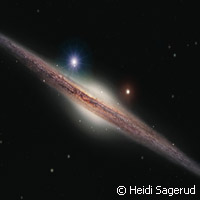Astronomers confirm location of new class of black hole
A little more than a year ago, European and US astronomers discovered a black hole millions of light years away and weighing over 500 solar masses. They labelled it Hyper-Luminous X-ray source 1 (HLX-1). Now the scientists from France, the UK and the US offer the world proof of the distance and brightness of this ultra-luminous X-ray source, confirming that it does indeed lie in a nearby galaxy and signalling a new class of black hole. Their findings, presented in The Astrophysical Journal, demonstrate that HLX-1 is neither in our own galaxy and nor is it a huge black hole at the heart of a distant background galaxy. The astronomers, led by the University of Leicester in the UK, say HLX-1 is the most extreme member of astronomical objects located in the ESO 243-49 galaxy which is situated around 290 million light years from our planet. Their findings effectively confirm HLX-1's extreme luminosity, which they describe as 'a factor of around 100 above most other objects in its class, and a factor of approximately 10 higher than the next brightest ultra-luminous X-ray source'. Because of this latest development, astronomers are compelled to reconsider their theories on the maximum brightness of ultra-luminous X-ray sources. The discovery also gives weight to the notion that an intermediate mass black hole may actually exist within HLX-1. Until now, scientists could not reliably detect such black holes. In their study, the scientists used the European Southern Observatory's (ESO) Very Large Telescope (VLT), which is located in Chile. Thanks to the VLT, the scientists confirmed the detection of HLX-1 in optical wavelengths and measured a specific distance to it. The bottom line is that HLX-1 is located within the ESO 243-49 galaxy, and is not a background galaxy or a foreground star. What this research shows is that ultra-luminous X-ray sources like HLX-1 can be brighter than was initially believed. We know that black holes are so dense, with such a powerful gravitational field, that nothing, not even light, can escape. 'After our earlier discovery of the very bright X-ray source, we were very keen to find out just how far away it really is, so that we can work out how much radiation this black hole produces,' explained Dr Klaas Wiersema of the University of Leicester, who is also the lead author of the paper. 'We could see on images taken with big telescopes that a faint optical source was present at the location of the X-ray source, located near the core of a large and bright galaxy. 'We suspected that this faint optical source was directly associated with the X-ray source, but to be sure we had to study the light of this source in detail, using the Very Large Telescope in Chile.' Dr Wiersema noted how the VLT was able to give the team very high-quality data, allowing them to separate the light of the expansive and bright galaxy from that of the faint optical source. 'Much to our delight we saw in the resulting measurements exactly what we were hoping for: the characteristic light of hydrogen atoms was detected allowing us to accurately measure the distance to this object,' he said. 'This provided conclusive proof that the black hole was indeed located inside the big, bright galaxy, and that HLX-1 is the brightest ultra-luminous X-ray source known.' The team plans to further investigate if there are more objects as extreme as HLX-1 and to compare the data they have about HLX-1 with bigger ultra-luminous X-ray sources. Not only would this information help them understand how many intermediate mass black holes exist, but they could determine their actual locations. Key contributions to this study were made by experts from France's Centre national de la recherche scientifique (CNRS) and the National Aeronautics and Space Administration (NASA) in the US.
Countries
France, United Kingdom, United States

